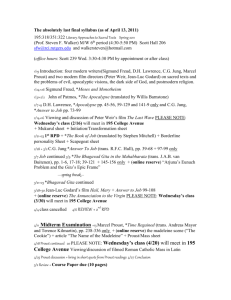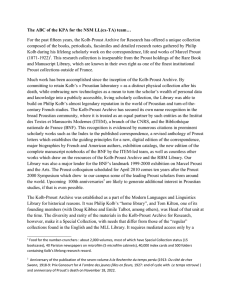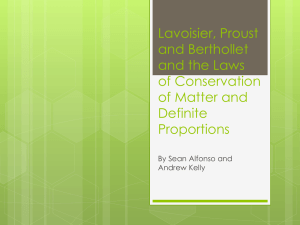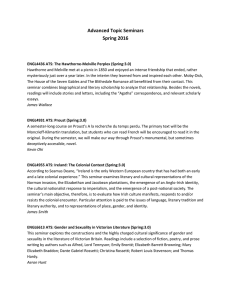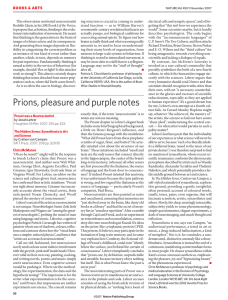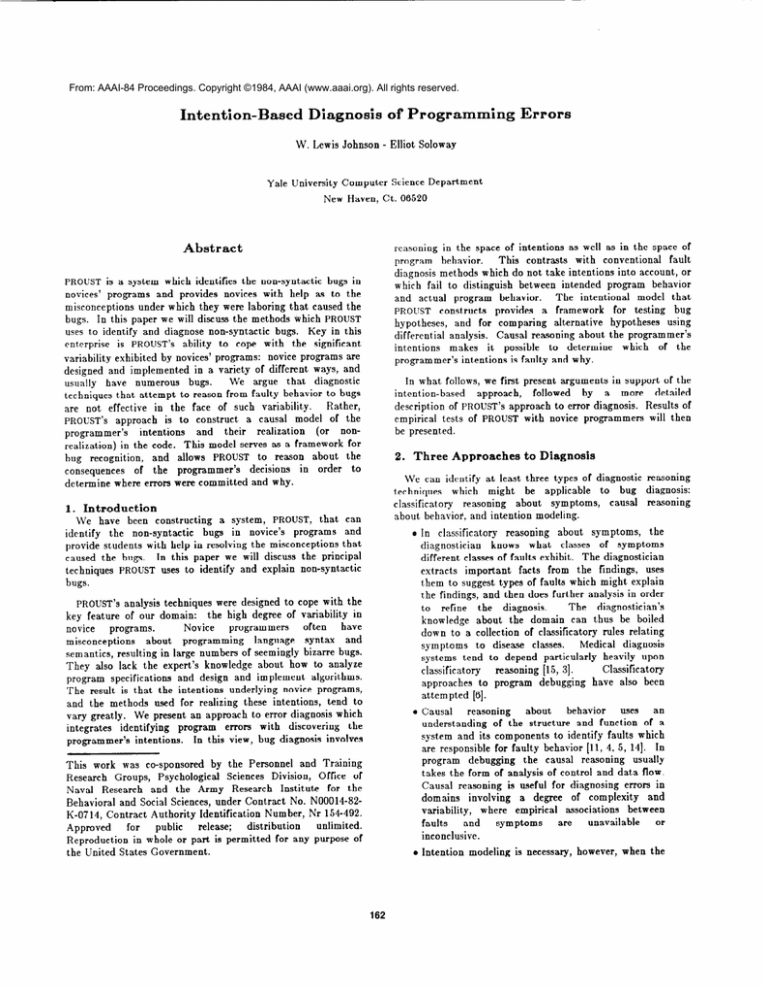
From: AAAI-84 Proceedings. Copyright ©1984, AAAI (www.aaai.org). All rights reserved.
Intention-Based
Diagnosis
of Programming
W. Lewis Johnson
Yale University
- Elliot
Computer
New Haven,
Science
variability
exhibited
by novices’ programs:
novice programs
are
designed
and implemented
in a variety
of different
ways, and
We argue
that
diagnostic
usually
have
numerous
bugs.
techniques
that attempt
to reason from faulty behavior
to bugs
Rather,
are not effective
in the face of such variability.
In what follows, we first present arguments
in support
of the
by
a more
detailed
intention-based
approach,
followed
to error diagnosis.
Results of
description
of PROUST'S approach
empirical
tests of PROUST with novice programmers
will then
be presented.
PROUST'S approach
is to construct
a causal
model
of the
nonand
their
realization
(or
programmer’s
intentions
This model serves as a framework
for
realization)
in the code.
and allows
PROUST
to reason
about
the
bug recognition,
decisions
in order
to
of the
programmer’s
consequences
1.
errors
were committed
2.
Introduction
l
PROUST's analysis techniques
were designed
to cope with the
the high degree of variability
in
key feature
of our domain:
have
Novice
programmers
often
programs.
novice
about
programming
language
syntax
and
misconceptions
semantics,
resulting
in large numbers
of seemingly
bizarre bugs.
They also lack the expert’s
knowledge
about how to analyze
program
specifications
and design and implement
algorithms.
The result is that the intentions
underlying
novice programs,
and the methods
used for realizing
these intentions,
tend to
vary greatly.
We present an approach
to error diagnosis
which
integrates
identifying
program
errors
with
discovering
the
In this view, bug diagnosis
involves
programmer’s
intentions.
for any
purpose
to Diagnosis
reasoning
diagnosis:
reasoning
In classificatory
reasoning
about
symptoms,
the
knows
what
classes
of symptoms
diagnostician
different
classes of faults exhibit.
The diagnostician
extracts
important
facts
from the findings,
uses
t,hem to suggest types of faults which might explain
the findings,
and then does further
analysis in order
The
diagnostician’s
to
refine
the
diagnosis.
knowledge
about
the domain
can thus be boiled
down to a collection
of classificatory
rules relating
Medic al diagnosis
symptoms
to disease
classes.
systems
tend to depend
particularly
heavily
upon
Classificatory
classificatory
reasoning
[15, 31.
approaches
attempted
to
[6].
program
debugging
have
also
been
behavior
uses
an
about
0 Causal
reasoning
understanding
of the structure
and function
of a
system and its components
to identify
faults which
are responsible
for faulty behavior
(11, 4, 5, 141. In
program
debugging
the causal
reasoning
usually
takes the form of analysis of control and data flow.
Causal
reasoning
is useful for diagnosing
errors in
domains
involving
a degree
of complexity
and
variability,
where
empirical
associations
between
unavailable
or
faults
and
symptoms
are
inconclusive.
This work was co-sponsored
by the Personnel
and Training
Psychological
Sciences
Division,
Office
of
Research
Groups,
Naval
Research
and the Army
Research
Institute
for the
Behavioral
and Social Sciences, under Contract
No. N00014-82K-0714, Contract
Authority
Identification
Number,
Nr 154-492.
unlimited.
public
distribution
for
release;
Approved
is permitted
Three Approaches
We can identify
at least three types of diagnostic
techniques
which
might
be applicable
to bug
classificatory
reasoning
about
symptoms,
causal
about behavior;, and intention
modeling.
and why.
We have been constructing
a system,
PROUST, that
can
bugs
in novice’s
programs
and
identify
the non-syntactic
provide students
with help in resolving
the misconceptions
that
In this paper we will discuss the principal
caused the bugs.
techniques
PROUST uses to identify
and explain
non-syntactic
bugs.
Reproduction
in whole or part
the United States Government.
Department
reasoning
in the space of intentions
as well as in the space of
program
behavior.
This contrasts
with conventional
fault
diagnosis
methods which do not take intentions
into account,
or
which fail to distinguish
between
intended
program
behavior
The intentional
model that
and actual
program
behavior.
PROUST
constructs
provides
a framework
for testing
bug
hypotheses,
and for comparing
alternative
hypotheses
using
differential
analysis.
Causal reasoning
about the programmer’s
intentions
makes
it possible
to determine
which
of the
programmer’s
intentions
is faulty and why.
PROUST is a system which identifies
the non-syntactic
bugs in
novices’ programs
and provides
novices with help as to the
misconceptions
under which they were laboring
that caused the
bugs.
In this paper we will discuss the methods
which PROUST
uses to identify
and diagnose
non-syntactic
bugs.
Key in this
to cope with the significant
enterprise
is PROUST's ability
where
Soloway
Ct. 06520
Abstract
determine
Errors
of
l
162
Intention
modeling
is necessary,
however,
when
the
programmer’s
intentions
are in odds with what the
Here,
the
programming
problem
requires.
problem
must
be
programmer’s
view
of the
determined
and then tied to the manner
in which it
has/has
not been realized.
Knowledge
of intentions
assists
the
diagnostic
process
in several
ways.
Predict,ions
derived from the intention
model enable
top-down
understanding
of buggy
code, so that
diagnosis
is not thrown
off when bugs obscure the
code’s intended
behavior.
The right fix for each
Finally,
causal
reasoning
bug can be found (81.
of
the
implementor’s
the
implications
about
intentions
makes it possible to test bug hypotheses
by looking
at other parts of the program
verifying
the implications
of bug hypotheses.
Problem:
Read in numbers,
number 99999 is seen. Report
the final 99999 in the average.
1
PROGRAM
2
VAR
3
will
argue
that
neither
classificatory
reasoning
about behavior
symptoms
nor causal reasoning
Rather,
fault
diagnosis
in novice
programs.
diagnosis
depends upon intention
modeling.
3.
is adequate
accurate
for
bug
sum := 0;
Count
:= 0;
7
Read(
Neu
8
YHILE
Neuo99999
the
values
between
New
Figure
and
99999,
i.e.,
We believe that the error in this program
is
of
that the student
wrote New : = Neu+l at line 12 instead
Read (New), as indicated
by PROUST's output,
which is shown in
the figure.
This bug is probably
the result of a programming
novices sometimes
overgeneralize
the counter
misconception:
increment
statement
and use it as a general
mechani. m for
getting the next value.
l
l
If a program
terminates
input,
test.
have
it may
before
an input
would
make
symptoms
to
it has
loop with
DO
:= Sum+Ner;
10
Sum
11
Count
12
Neu
:=
Count*l;
:= Neu+l
END;
14
Avg
15
Uriteln(
:=
Sum/Count;
‘The
average
is
‘,
avg
1;
END;
read
use of
causes.
Example
of analysis
of a buggy
program
Canonicalization
tee hniques [I]
the
student’s
translate
program
into a canonical
dataflow
representation
and compare
it against
an idenlized correct program
model.
Again the aim is
to determine
intentions
by comparison.
Such comparisons
are
easier to make, but only if the student’s
intended
algorithm
is
the same as the model algorithm.
Non-trivial
programming
problems
can be solved in any of a number of ways.
Thus an
approach
which
compares
against
a single
model
solution
cannot cope with the variability
inherent in programming.
enough
a faulty
1:
2) compare
it against
a description
of what
the
program,
program
is supposed
to do, in order to identify errors, and then
3) trace the erroneous
results back to the code which generated
them.
In the example in Figure 1, we would determine
that the
program
computes
New/2+49999.5, compare
this against
what
(CNew)/count(New),
then examine
it should compute,
namely
the parts of the program
which compute
the erroneous
parts of
The main problem
here is that it is hard to
the formula.
compare
these two expressions
and determine
which parts are
This requires
knowledge
of which components
of the
wrong.
first expression
correspond
to which components
of the second
expression.
Expression
components
correspond
only if their
underlying
intentions
correspond.
Thus some knowledge
of the
programmer’s
intentions
is necessary
in order for the symbolic
execution
approach
to generate
reliable results.
(Neu+99999)/2.
approach
A symptom
classification
general
heuristic
rules
for relating
Example rules might be the following:
) ;
It appears that you were trying to use line 12 to read the
next input value. Incrementing NEW will not cause the next
value to be read in. You need to use a READ statement
here, such as you use in line 7.
Figure
1 shows a programming
problem,
to compute
the
average
of a series of inputs,
and an actual
buggy
student
solution.
Instead
of reading
a series of inputs and averaging
them, this program
reads a single number New, and outputs
the
all
1;
output
INTEGER;
PROUST output:
We will first walk through
an example
of bug diagnosis
in
order to contrast
the intention-based
approach
to the other
Further
details of how intention-based
diagnostic
approaches.
diagnosis
works will be provided
in subsequent
sections.
of
input,
Neu:
BEGIN
16
Intention-Based
Diagnosis vs. Qther
Approaches:
An Example
average
REAL;
6
9
about
Avg:
5
13
We
Count,
sum, until the
Do not include
BEGIN
4
and
Average(
Sum.
taking their
the average.
exit
If a program
outputs
a value which is too large,
check the line that computes
the value and make
sure that it is correct.
Neither
of these rules addresses
the true cause of the bug;
instead
of focusing
on the way new values are generated,
one
rule focuses
on the exit test, and the other focuses
on the
average
computation.
In general,
many
different
program
faults can result in the same symptoms,
so knowledge
of the
symptoms
alone is insufficient
for distinguishing
faults.
Troubleshooting
approaches
suffer from similar difficulties
as
symbolic
execution.
In program
troubleshooting,
the user is
expected
to describe the specific symptoms
of t,he fault, rather
than give a description
of the intended
output.
The system
then traces the flow of information
in the program
to determine
what might have caused the symptoms.
In this example
the
computes
New/2+49999.5.
We
symptom
is that the program
have already
seen in the case of symbolic
execution
that this
information
alone is not sufficient
to pinpoint the bug.
The
principal
diagnostic
methods
which
employ
causal
analysis
of behavior
are symbolic
execution,
canonicalization,
and troubleshooting.
If we followed
a symbolic
execution
paradigm,
as in PUDSY [lo], we would go through
the following
sequence
of steps:
1) use causal
knowledge
of program
semantics
to derive a formula
describing
the output
of the
Because
of the problems
behavior
pose in debugging,
163
that
analysis
of symptoms
and
a number of implementors
of bug
have
augmented
these
techniques
with
systems
for
stereotypic
programming
plans[13, 12, 161.
recognizers
This is an attempt
at determining
the intentions
underlying
the
code; by recognizing
a plan we can infer the intended function
of the code which realizes
the plan, which in turn helps in
localizing
bugs.
Unfortunately
plan recognition
by itself is not
adequate
for inferring
intentions.
First, bugs can lead to plan
In the example,
the loop looks like a
recognition
confusions.
counter-controlled
iteration;
diagnosing
the bug requires
the
realization
that
the loop was not intended
to be counter
controlled.
Second, bugs may arise not in plans themselves,
but
in the way that
they interact
or in the manner
that
the
extent one can
programmer
has employed
them.
To a certain
determine
the interactions
of plans in a program
by analyzing
However,
we will
the flow of information
among
the plans.
diagnosis
consider
examples
in the next section where the intended
plan
interactions
and the actual
plan interactions
are different.
In
such
cases
a better
understanding
of the
programmer’s
intentions
is needed
than
what
plan recognition
alone can
provide.
programmer’s
so PROUST
hypothesize
program.
4.1.
Shallow
relations
between
goals
and plans,
on one hand,
and rules
about
how goals combine
and interact,
on the other hand, to suggest
possible
goal structures
for the program.
The goal structure
that fits the best suggests
that the Read at line 7 satisfies the
goal of initializing
the YHILE loop; the loop is organized
to
process each value and then read the next value at the bottom
of the loop, in a process-n-read-nextn
fashion.
Lines 5 and 10
are responsible
for totaling
the inputs,
lines 6 and 11 are
responsible
for counting
them,
and line 14 computes
the
average.
Given this model, there is no role for the New :=
New+1 to serve other than
as a means to read the next value
inside the loop.
This leads directly
to the conclusion
that the
student
has overgeneralized
the use of counter
increment
statements.
4.
Examples
of Intention-Based
Diagnosis
Program
analysis
in PROUST
involves
a combination
of
shallow
reasoning
for recognizing
plans and bugs, and causal
reasoning
about
intentions.
The relative
importance
of each
kind
of reasoning
depends
upon
the
complexity
of the
program’s
goal structure
and the extent to which PROUST must
of the programmer’s
design decisions
analyze
the implications
and misconceptions
to determine
what bugs they cause.
We
will show how PROUST reasons
about
programs
and bugs by
way of a series of examples.
The first program
example has no
bugs,
and
has
a simple
goal
structure;
accordingly,
the
reasoning
processes
involved
in understanding
it are primarily
shallow.
The next example has bugs, and the goal structure
is
somewhat
more complex;
although
the bugs are discovered
via
shallow
recognition
tactics,
a greater
amount
of reasoning
about intentions
is required to construct
the right goal structure
and test the bug hypothesis.
In the third
example
the
reasoning about correct programs
Figure 2 shows a typical introductory
programming
problem.
Figure 3 shows the plan analysis of a straightforwardly
correct
and the
solution,
i.e., one in which the intentions
are correct
implemented
in
accordance
with
rules
of
program
is
PROUST
is supplied
wit.h a
programming
discourse
[17].
description
of the programming
problem,
shown in Figure 4,
which reflects
the problem
statement
which the students
are
This description
is incomplete,
in that
details
are
given.
omitted
and terms are used which must be defined by reference
PROUST
to PROUST'S knowledge
base of domain
concepts.
derives from the problem
description
an agenda of goals which
must, be satisfied
by the program.
PROUST must go through
a
process
of building
hypothetical
goal structures
using these
goals, and re:ating
them to the code.
We call this process
constructing
In contrast
to these other approaches,
the intention-based
approach
attempts
to construct
a coherent
model of what the
programmer’s
intentions
were and how they were realized
in
the program.
Instead of simply listing the plans which occur in
the program,
one must build a goal structure
for the program;
i.e., one must determine
what the programmer’s
goals were,
and how he/she went about realizing those goals, using plans or
some other means.
This is accomplished
in PROUST as fo!!ows.
PROUST is given an informal
description
of what the program
is
It then makes use of a knowledge
base of
supposed
to do.
intentions
are not reflected
directly
in the code,
must use knowledge
about
goal interactions
to
and differentiate
possible intention
models for the
interpretations
of the code.
The goal structure
for a given program is built by selecting
goals to be processed,
determining
what plans might be used to
them against
the
implement
these goals, and then matching
code.
Let us consider what happens
to the Sentinel-Controlled
This goal specifies that input should be
Input Sequence goal.
read
and processed
until
a specific
sentinel
value
is read.
PROUST must determine
what plans might be used to realize
PROUST
has
a knowledge
base of typical
this
goal.
programming
programming
plans,
goals.
and
another
knowledge
base
of
Each plan is indexed according
t.o the
goals it can be--used
to implement,
end each goal linked to
of subgoals
which
implement
it.
plans
and/or
collections
PROUST
retrieves
from these databases
several
plans which
One of these, the SENTINEL-CONTROLLED
implement
the goal.
PROCESSREAD
WHILE PLAN, is shown in Figure 3. This plan
specifies
that there should be a UHILE loop which reads and
processes
input in a process-n-read-next-n
fashion;
we saw a
buggy instance
of this plan in the program
in Figure 1.
Noah needs to keep track of rainfall in the New Haven area
Write a
in order to determine when to launch his ark.
program which he can use to do this. Your program should
read the rainfall for each day, stopping when Noah types
“99999”, which is not a data value, but a sentinel indicating
the end of input.
If the user types in a negative value the
program
should reject it, since negative rainfall is not
Your program should print out the number of
possible.
valid days typed in, the number of rainy days, the average
rainfall per day over the period, and the maximum amount
of rainfall that fell on any one day.
Figure
2:
The Rainfall
Problem
Each plan consists
of a combination
of statements
in the
target
language,
Pascal,
and
subgoals.
The syntax
and
semantics
of plans, and the methods
used for matching
them,
are discussed
in detail in 171. Matching
the plan against
the
code involves
1) finding
statements
which match
the Pascal
additional plans
part of the plan, and 2) selecting and matching
to implement
the plan’s subgoals.
For example,
the WHILE loop
at line 4 matches
the Pascal pak of the plan.
This plan also
has
two
subgoals,
both
Input
goals.
The
plans
for
implementing
these goals which match the code are both READ
GOALS
Sentinel-contrdled Input Sepaenee(?Ra
Olrtprt( Average(?RaInfalI)
)
We encourage
this by including
plans in our introductory
We can therefore assume that plans
programming
curriculum.
will play a major role in the construction
of the programs that
We
assume
furthermore
that
if a
PROUST
analyzes.
Infa I I, 99999)
Smm(i’Rainfall)
Constants:
%top
Variables: ?Mev
?Total,
?Neu
Template:
hit:
rabpal Inprt(?Neu)
hfain loop :
WHILE
?TotaI
?Newc>7Stop
END
COUNT
4.2.
= ?Total*PNeu
We will now look at an example which involves integrating
of constructing
program
bug recognition
into the process
Recall that the problem statement
in Figure
interpretations.
2 requires that all non-negative
input other than 99999 should
be processed.
However, the program in Figure 5 goes into an
infinite loop as soon as a non-negative
value other than 99999
The reason is that the YHILE statement
at line 13
is read.
should really be an IF statement.
The programmer
is probably
confused
about the semantics
of nested WHILE statements,
a
common
difficulty
for
novice
Pascal
programmers
[Q].
Otherwise
the the loop is constructed
properly.
Apparently
how YHILE loops work when the body
programmer
understands
of the loop is straight-line
code, but is confused
about how
multiple
tests are integrated
into a single loop.
We will show
how PROUST develops this interpretation
for the program.
rcgment hxese: of goal
Read d proceacr)
I
(in
Nezt: subgoal Input(?Neu)
=0,
= Of-
Update:
DO
7TotaI
MAX
programmer
uses plans correctly, and if they fit together into a
coherent
design, then the functionality
of the plans corresponds
intentions.
closely to the programmer’s
Variables:
Template:
=O.
RAINY
=O.
READLN.
READ(N)
WHILE
N<,STOP
DO
BEGIN
IF N>=O
THEN
BEGIN
SUM
=SUM*N.
COUNT
10
=COUNT+l.
IF N>MAX
11
MAX
12
IF N>O
13
THEN
RAINY
14
THEN
=N.
=RAINY+l,
END
15
ELSE
16
WRITELNC'ENTER
WRITELNCN
0 2,'
IS NOT
POSSIBLE,
REENTER').
RAINFALL'),
READLN,
+
:;
+
19
READ(N)
END,
Figure
3:
Plan Recognition
SINGLE VALUE plans, i.e., READ statements
which
values.
The SENTINEL-CONTROLLED
PROCESSREAD
matches- ;he program
the goal structure.
so this plan is incorporated
PROCESSREAD
Constants:
%top
Variables:
Template:
?Ratnfall.DatlyRain
Sentinel-Controlled
Input Vulidation(
Type
Input Sequence(
Scaladeasurement;
Aoerage(
Figure
)
Count(
7Rainfall.DailyRain
Count(
?Ralnfall,DailyRain
hf~~imum(
4:
READ-PROCESS
constants:
variables:
Template:
7Neu
99999
REPEAT
xtop
7Neu
),
)
?Rainfall:DallyRaln
s
Outputf
WHILE
Initinpt:
?Ra i nfa I I.DailyRain.
interpretations
?Ratnfall’DaclyRaln,
?Ralnfall.DailyRaln<O
Output(
Output(
Outputt
into
program
The bug in this example
is encountered
while PROUST
is
processing
the Sentinel-controlled
input aequcncc goal.
Two
plans implementing
this goal match the code:
the SENTINEL
PROCESSREAD
WHILE PLAN, which we saw in the previous
example,
and the SENTINEL READ-PROCESSREPEXTPLAN.
The
WHILE loop plan matches the loop starting at line 13, while the
REPEAT loop plan matches the loop starting at line 3.
Rainfall,
DefProgram
DefObJect
exactly,
read single
PLAN thus
Differentiating
t
)
?RainfalI
?RainfalI
Representation
).
);
DailyRain>O
.Dai
IyRain
)
)
);
);
of the Rainfall
Problem
goals
from the agenda
and
PROL’ST continues
ae!ecting
ping them to the code, until every goal has been accounted
map
for. This involves some analysis of implications
of plans.
For
example,
the choice of plan for computing
the Average goal
implies that a Sum goal be added to the goal agenda. This is
in turn implemented
using a RUNNING TOTAL PLAN, shown in
the figure. - However, in a-program such as this relatively
little
work 7s involved
in manipulat&g
the goal agenda; most-of the
work in understanding
this program is in the plan recognition.
4
WRITELN
5
READLN,
6
READ
7
WHILE
8
RAIN
< 0 DO
9
WRITELN
:0
READLN.
READ
12
END
13
WHILE
14
( RAIN
( RAIN
SIBLE,
REENTER'!,
)
<) 99999
DAYS
* DAYS
16
TOTALRAIN
IF RAIN
18
DO
=
1,
TOTALRAIN
= RAINDAYS
IF HICHRAIN
19
l
l
RAIN,
> 0 THEN
RAINDAYS
20
Figure
P
p
RAIN
17
22
0 2,'NOT
BEGIN
15
HIGHRAIN
21
PROUST is thus able to analyze
straightforwardly
correct
programs
primarily
using shallow
plan recognition
techniques.
We have argued elsewhere 1171
This is not a surprising
result.
that programmers
make extensive use of stereotypic
plans when
writing
and understanding
programs.
Furthermore,
we have
evidence
that novice programmers
acquire plans early on [2].
RAINFALL').
BEGIN
11
*
('ENTER
(RAIN),
< RAIN
l
1,
THEN
- RAIN
END
UNTIL
6:
RAIN
= 99999,
Program
Requiring
Shallow
Bug Reasoning
Although
the Pascal portions
of these plans match fairly
closely, difficulties
arise when the subgoals
are matched against
the program.
Consider first the REPEAT loop plan. It indicates
that
there
should
be an Input
subgoal
at the top
of the loop,
and the remainder
of the loop should be enclosed in a Sentinel
Guard,
i.e., a test to see if the sentinel
value has been read.
There is in fact a READ statement
at line 6 which could satisfy
However,
the code which follows, at line 7, is
the Input goal.
guard; instead, it is a loop that performs
more
not a sentinel
input.
This indicates
that there is a flaw in this model of the
subgoal
structures
which
hypotheses
to consider.
code.
A similar problem arises when PROUST tries to match the
The problem
there is that the plan indicates
loop plan.
that there should be an Input goal above the loop, but PROUST
finds the loop at line 7 interposed
between the initial read and
the apparent
main loop at line 13.
WHILE
current
in the case of the SENTINEL-CONTROLLED
WHILE PLAN lines 6 through
12 is viewed
as
initial input, and in the case of the REPEAT plan
of code are viewed as the main input inside the
thus
enumerating
diagnosis
for this program.
the
program
behavior
would
probably
be fooled
by this
program,
because they would treat the WHILE statement
at line
13 as a loop, rather
than as an IF statement.
Such a system
might
be able to determine
that the program
goes into an
infinite
loop, but it would
not be able to explain
to the
programmer
why his/her intentions
were not realized.
Given t,hese interpretations
of the subgoals,
the main loop
plans still do not quite match.
The remaining
differences
are
camp:;: I’Jr against PROUST's bug catalog.
This catalog
has been
built via empirical
analyses
of the bugs in hundreds
of novice
programs
191. It consists of production
rules which are triggered
by plan differences
and which chain, if necessary,
in order to
account
for all the plan differences.
In the case of the REPEAT
loop plan, the plan difference
is that
a UHILE statement
is
found
instead
of an IF statement;
this is listed in the bug
catalog,
along with the probable
associated
misconception.
In
the case of the WHILE loop plan, there are two plan differences:
the Input subgoal
is missing
from inside the loop, and the
entire loop is enclosed
inside of another loop.
The missing
input is fisted in the bug catalog;
novices sometimes
have the
misconception
that a READ statement
is unnecessary
in the loop
if there is a READ statement
elsewhere
in the program.
The
enclosing
loop bug is not listed in the catalog;
that does not
mean
that this is an impossible
bug, only that there is no
canned explanation
for this kind of plan difference.
constructed
two different
of the Sentinel-Controlled
be present,
We see in this example
that although
shallow reasoning
is
used to recognize
plans
and bugs, this works only because
causal reasoning
about the programmer’s
intentions
provides
a
framework
for performing
plan and bug recognition,
and for
The intention
model makes it possible
interpreting
the results.
to employ differential
diagnosis
techniques,
which helps PROUST
arrive at the correct
interpretation
of the program
even when
bugs make it difficult to determine
what plans the programmer
was trying
to use. In contrast,
analysis methods
which analyze
The first step in resolving the plan differences
associated
with
the looping
plans is to restructure
the subgoals
in order to
reduce the differences,
Besides the READ SINGLE VALUE plans,
PROUST has other plans which can be used for input.
One plan
is a WHILE loop which tests the input for validity
as it is being
read, and rereads it if the data is not valid.
This plan satisfies
two
goals
simultaneously,
Input
and
Input
Validation.
However,
Input
Validation
is also on the goal agenda,
so
PROUST combines
the two goals and matches
the plan. The
We have thus
implementation
might
Choosing
from among the possible interpretations
proceeds as
If there
is an interpretation
which
is reasonably
follows.
complete,
and which is superior
to competing
interpretations,
PROUST picks it, and saves the alternatives,
in case evidence
comes up later which might invalidate
the decision.
Here the
REPEAT loop interpretation
is superior,
because each part of the
plan has been accounted
for, albeit with bugs.
The YHILE loop
interpretation
is not as good, because the embedded
loop plan
difference
is unexplained,
and because the Input subgoal inside
the loop was never found.
PROUST therefore
adopts the REPEAT
and adds the “while-forif”
bug to the
loop interpretation,
Mismatches
between
plans
and
codes
are called
plan
differences;
whenever
a plan fails to match
exactly
a plan
difference
description
is constructed
describing
the mismatches.
There are two mechanisms
which are used for resolving
plan
differences.
One is to look for some other way of structuring
the subgoals
of the plans to match the code better.
The other
is to come up with an explanation
of the plan mismatch
in
terms of bugs or plan transformations.
Both mechanisms
are
needed in this example.
result
is that
PROCESS-READ
performing
the
these same lines
loop.
considered
to match
buggy code.
The only way to interpret
code
when
bugs
are present
is to consider
the possible
interpretations
and pick one which appears
to be better than
the others.
In other words, PROUST must perform
differential
The
diagnosis
in order
to pick the right
interpretation.
intention
model
makes
it possible
to construct
such
a
differential;
PROUST
uses it to predict
possible
plans
and
4.3.
Differentiating
intention
models
Figure 6 shows a program
which requires
deeper analysis
of
the programmer’s
intentions.
This example
illustrates
how
programming
goals
are sometimes
realized
indirectly
in a
program,
by interacting
with the implementation
of other goals.
Debugging
such programs
requires the ability to reason about
goal
interactions
in order
to differentiate
models
of the
programmer’s
intentions.
Causal reasoning
about intentions
is
essential in this enterprise.
Let us examine how PROUST maps the goal Input Validation
onto this program,
i.e., how it determines
how bad input is
filtered
from the input stream.
One plan which implements
the
this goa! is the BAD INPUT SKIP GUARD, which encloses
computations
in the loop with
an IF-THEN-ELSE
statement
which tests for bad input.
PROUST discovers
plan differences
PROUST
when it tries to match this plan against the program.
can find a test for bad input in the loop, but it is too far down
in the loop, and it does not have an ELSE branch. It also
NUMBER
contains
an unexpected
counter
decrement
statement,
:= NUMBER-l.
It turns
out that these plan differences
are
explained
not by postulating
a bug in the BAD INPUT s~.rp
interpretations
of the
Input Sequence
in
this program.
There are others which we have not listed here.
It is necessary
to construct
all these different
interpretations,
instead
of just picking the first one that appears
reasonable,
because there is no absolute criterion for when a plan should be
GUARD
structure
166
plan,
but by inferring
for the program.
an
altogether
different
goal
Input
Validation(?RainfaI
BAD INPUT
I :Dsi
IyRsir.
?Roinfol
lyroin<O)
activates
two demons.
The first demon tests hypothesis
1, by
looking
for plans which
satisfy
the contingency
test and
checking
to see that bad input has been accounted
for.
The
other demon tests hypothesis
2, by looking for cases where bad
SKIP GUARD
Variables:
Template:
'Val.
?Pred
Errors
1) Test
(in uegmen t FPocess: of Read d process)
spanned by
Teet :
IF
I :Doi
7Pred
THEN
subgoal Output diagnostic(j
part
(should
Process
input
should
have been checked
for but was not, and for
alternative
explanations
for the code which is attributed
to the
contingent
goal.
Each demon finds one case supporting
its
respective
hypothesis.
The program compensates for the effect
of bad input on the counter, NUMBER, which serves as evidence
for the contingent
goal hypothesis.
However, the program does
not compensate
for the effect of bad input on the running total,
TOTAL; this serves as evidence
that the Input Validation
goal
was not implemented
at all.
This does not mean that the
hypotheses
are equally
good,
however.
Hypothesis
1 can
account
for the running
total being unguarded
if we presume
that the programmer
left that case out by mistake.
Hypothesis
2 cannot
account
for NUMBER := NUMBER-1
line at a!!; it would
have to be dismissed
as spurious code. PROUST avoids program
interpretations
which cannot
account for portions of the code.
Therefore
PROUST can assume that the programmer
has the
contingent
input validation
goal in mind.
mtsplaced
be at top
part
of
of
loop)
'2) ELSE
branch
3) Unexpected
mtsslng
counter
decrement
ELSE
Proceee
:
?*
YHILE RAINFALL
NUNBER
IF
‘=
0
RAINFALL
DAYS
IF
:=
TOTAL
IF
+
> 0
DAYS
RAINFALL
HICHEST
99999
NUMBER
)
W
BEGIN
1;
THEN
+
1;
HIGHEST
THEN
= RAINFALL;
:=
TOTAL
RAINFALL
+
RAINFALL;
< 0
THEN
(*BAD
INPUT');
hypothesis
2
-
satisjies
3
satisfies
hypothea’r 1
conclusion: hypothesis f
BEGIN
YRITELN
NUNBER
.=
NUHBER
-
1;
END.
READLN;
READ
Knowledge
about how a goal structure was derived by the
student
makes
it possible
for PROUST to help the student
iru prove his programming
style.
This program can be fixed by
adding a line TOTAL := TOTAL-RAINFALL
next to the NUMBER :=
NUMBER-1
line.
This is not the right correction
to suggest:
it
was a mistake
for the programmer
to validate
the input in a
is satisfied
( RAINFALL)
END;
Contingency(
Hypothesis
1:
conttngent
goal
E/Jetted-by(
Compensate(
Figure 6:
present
?Plan.
?Plan.
Hypotheses
2:
contingent
goal
(?RainfalI
:DailyRain<O)
(?Rainfal
I.DoilyRain<O)
Differentiating
Intention
absent
contingent
fashion in the first place.
A single plan could have
implemented
the input validation
directly, and the fact that the
programmer
overlooked
one of the contingencies
demonstrates
that
indirect
goal
implementations
are harder
to perform
1 1
Models
assumed
that a single plan would
be used to
the Input Validation
goal.
Instead, two plans are
one prints out a message when bad input
program:
and the other decrements
the counter NUMBER when
is read in. In fact, for this design to be correct, there
PROUST
implement
used in this
is read in,
correctly.
As we see in the output which PROUST generates for
this bug, shown in Figure
7, PROUST suggests to the student
that he re-implement
the Input Validation
goal.
Thus causal
reasoning
about intentions
not only makes it possible to find
bugs in complex
programs,
it makes it possible to correct the
reasoning
that led to the occurrence
of the bugs.
bad input
would have to be a third plan, which subtracts bad input from
We must therefore reformulate
the
the running total, TOTAL.
Contingency(
as a contingent
goal:
Input
Validation
(?Rainfal
I:DailyRain<O)
>,
?Plan,
Effected-by(
(?Rainfal
I :Doi lyRain<O)
1 1.
This
Compensate{
?P Ian,
goal states that whenever
a plan is effected by the rainfall
for this
variable being less than zero, a goal of compensating
effect must be added to the goal agenda.
If we assume that
bad input was being filtered in a contingent
fashion, then input
will be tested when it might effect the result; it would not be
tested when the maximum,
HIGHEST,
is computed,
for example.
This hypothesis
is generated
by a bug rule which fires when
PROUST
tries to explain
the plan differences
listed in the
This rule stipulates that whenever a guard
previous paragraph.
The sum is not shielded against invalid input. If the user
types in a bad value it will be included in the sum. I noticed
that you do test for bad input elsewhere.
Your program
would really be simpler if it tested the input in one place,
before it is used, so bugs like this would not crop up.
Figure
6.
7:
PROUST
output
for the program
in Figure
6
Results
To t,est PROUST, we performed
off-line analysis of the first
syntactically
correct
versions
of 200 different solutions
to the
Rainfall
Problem.
A team of graders debugged
the same
programs
by hand, to determine
the actual number of bugs
present.
The results are shown in Figure 8, labeled “Test 1”.
plan only guards
part of the code that is supposed to guard, a
new goal structure
should be created in which the guard goal is
reformulated
as a contingent
goal.
For each
analyses.
Testing
a contingent
goal hypothesis
is difficult,
because
it
depends upon what plans are used to implement the other goals
l
in the agenda, and PROUST does not yet know what those plans
are. PROUST must construct
a differential of two goa! structure
hypotheses:
hypothesis
1 holds that Input Validation
has been
reformulated
as a contingent
goal, and hypothesis
2 holds that
the programmer
neglected
Input Validation
altogether,
and the
code which appears to guard against bad input really serves
In order to test these hypotheses,
PROUST
another purpose.
l
167
program
Complete
structure
regards
it
PROUST
generates
one
of
three
kinds
annlysis:
the mapping
between
goal
and code is complete
enough that PROUST
to be fully reliable.
Partial
analysis:
significant
portions
of the
program
were understood,
but parts of the program
could not be analyzed.
PROUST deletes from its bug
report any bugs whose analysis might be effected by
the unanalyzable
code.
of
l
PROUST's analysis of the program
No analysie:
and unreliable,
and was
was very fragmentary,
therefore
not presented
to the student.
4.
In Test 1, 75% of the programs
received
complete
analyses;
PROUST found 95% of the bugs in these programs,
including
20% of the programs
were
many
that the graders
missed.
partially
analyzed,
and 5% got no analysis.
lest
Total
number
of
Number
analyzed
Total
number
Bugs
recognized
Bugs
not
False
Number
Total
531
correctly:
502 (95%)
29 (5%)
46
alarms
analyzed
partially'
number
of
recognized
Bugs
deleted
Bugs
not
Number
155 (75%)
bugs:
recognized
40 (20%)
220
bugs
correctly.
from
bug
report:
recognized
79
(36%)
80
(36%)
61 (28%)
36
alarms
unanalyzed.
lest
8:
Results
lest
2
53 (70%)
252
247 (98%)
5 (2%)
18
33
163
65
58
40
20
19 (25%)
105
42 (40%)
36 (34%)
of running
(40%)
(36%)
(25%)
7.
of Computer
be because
of problems
in transporting
6.
Concluding
4 (5%)
PROUST from the
the
Classifying
Bugs
on Soft. Eng.,
and Debugging
Programs.”
12 (ISgO), 189-202.
13. Shapiro,
D. G. Sniffer: a System that Understands
Tech. Rept. Al Memo 638, MIT Artificial
Intelligence
Laboratory,
June, 1981.
14. Shapiro,
E.. Algorithmic
Cambridge,
Mass., 1982.
Program
15. Shortliffe,
E.H.. Computer-Baaed
MYCIN. American
Elsevier Publishing
on
Debugping.
Bugs.
MIT Press,
Medical Consultationa:
Co., New York, 1978.
16. Soloway, E., Rubin, E., Woolf, B., Bonar, J., and Johnson,
W. L. “MENO-II:
An Al-Based
Programming
Tutor.”
Journal of Computer-Baaed
Instruction
IO, 1 (1983).
17.
Soloway,
Programming
to Debug
15 (1980),
Sci., 1984.
Lukey, F.J. ‘Understanding
J. of Man-A4achine
Studiea
Engineering
A System
Diagnosis of Programming
University
Department
Yale
12. Sedlmeyer,
R. L. and Johnson,
P. E. Diagnostic
Reasoning
in Software
Fault Localization.
Proceedings
of the
SIGSOFT
Workshop
on High-Level
Debugging,
SIGSOFT,
Asilomar,
Calif., 1983.
were
these
time
Test
References
Intelligence
a
11. Pople, H. E. Heuristic Methods for Imposing
Structure
I!! Structured
Problems:
The Structuring
of Medical
Intelligence
in
Diagnostics.
In Szolovits, P., Ed., Artificial
Medicine, West View Press, 1982.
Remarks
“LAURA,
Conf.
9. Johnson,
W.L., Soloway,
E., Cutler, B., and Draper, S. Bug
Collection:
I. Tech. Rept. 296, Dept. of Computer
Science, Yale
University,
October,
1983.
10.
ht.
PROUST
We have
argued
that
intention-based
understanding
is
needed
in order
to diaqntise
errors
effectively
in novice
Knowledge
of intentions
makes
it p3ssib!e
for
programs.
PROUST to grapple with the high degree of variability
in novice
programs
and novice programming
errors, and achieve a high
level of performance.
Intention-based
diagnosis
is complex,
but
our results suggest that it is tractable
for non-trivia!
programs.
This
gives
us optimism
that the remaining
obstacles
to
achieving
high performance
over a wide range
of student
populations
and programming
problems
can be overcome
in due
course.
1. Adam, A. and Laurent,
J.
Artificial
Student
Programs.”
Paths of
Proc. of the Nat.
1983, pp. 88-94.
8. Johnson,
L., Draper, S., and Soloway, E.
is a Tricky Business.
Proc. NASA Workshop
1983.
We have
recently
made
on-line
tests
of PROUST in an
The column
labeled
uTest
introductory
programming
course.
Unfortunately
the
PROUST’s performance.
2” summarizrs
percentage
of complete
analyses
went down.
This turned out
to
Johnson,
\Y.L. Intention-Based
Tech. Rept. forthcoming,
Errors.
17
research
environment
to the classroom
environment,
and
not due to essential flaws in PROUST itself. We corrected
problems
and re-ran PROUST on the same set of data; this
PROUST’S performance
was comparable
to what it was in
1. We also ran PROUST on another
programming
problem;
results of that test have yet to be tabulated.
via Causal Reasoning:
6. Harandi,
hi,T.
Knowledge-Baaed
Program
Debugging:
Heuristic
Mode!.
Proceedings
of the 1983 SOFTFAIR,
SoftFair,
1983.
27 (26%)
13 (17%)
Diagnosis
and the Locality Principle.
Intelligence,
AAAI, August,
278-283.
76
(43%)
R.
5. Geneseret h, M. Diagnosis Using Hierarchical
Design
hilodels.
Proc. of the Nat. Conf. on Art. Intelligence, 1982, PP.
Repeated
30 (39%)
133
131 (98%)
2 (2%)
5
11 (5%)
Figure
2
76
206
completely.
of
Bugs
False
programs:
1
Davis,
!nteract,ion
on Artifical
75-122.
2.
Bonar, J. and Soloway, E. Uncovering
Principles
of Novice
Programming.
SIGPLAN-SIGACT
Tenth Symposium
on the
Principles
of Programming
Languages,
1983.
3. Chandrasekaran,
B. and Mittal, S. Deep Versus Compiled
Knowledge
Approaches
to Diagnostic
Problem-Solving.
Proc.
of the Nat. Conf. on Artificial
Intelligence,
AAAI,
August,
1982, pp. 349-354.
168
E. and Ehrlich, K. “Empirical
Investigations
of
Knowledge.”
IEEE Tran8actions
of Software
SE-IO, In press (1984).


